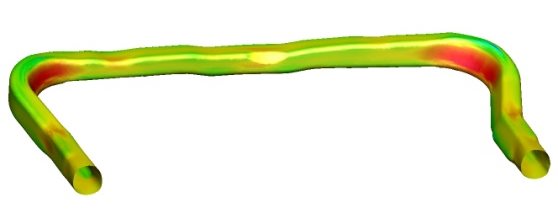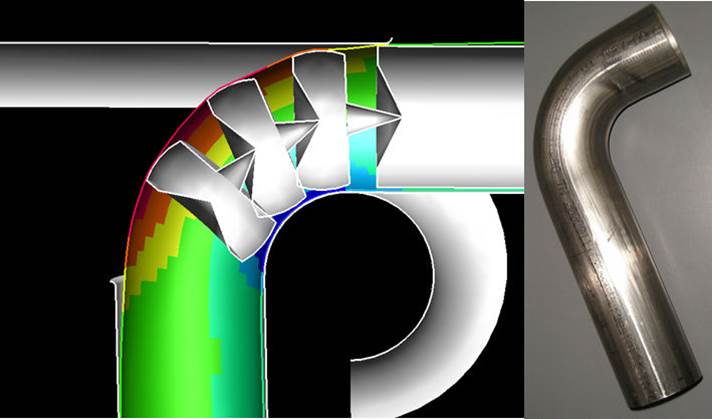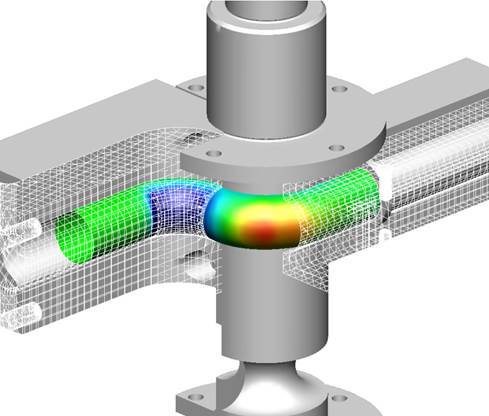Tube Bending and Hydroforming
In response to market demand to form complex parts with small bend ratios, PAM-STAMP offers accurate tube bending simulation with realistic tool modelling and behavior for better forming results to avoid downstream problems.
Hydroforming is an advanced forming technique that gives the possibility of forming complex parts and improving surface quality. Liquid bulge forming and high pressure techniques can be modelled separately or combined within PAM-TUBE, covering the whole range of tube forming processes.
Its easy-to-use user environment ensures time-saving process setup and tool design and helps the user handle the complexity of hydroforming processes.

Tube bending in PAM-STAMP was developed in cooperation with academic and industrial institutions. The partnership with the University of Siegen and the close cooperation with DaimlerChrysler, Audi, Schuler Hydro Forming, bu+Engineering Gmbh, hde Solutions, Eberspâcher and ThyssenKrupp Budd resulted in a robust industrial software, which allows the reliable simulation of bending and hydroforming of tubes. It includes special functions for:
- Estimation of strains,
- Prediction of ovalisation,
- Rapid detection of the bending line,
- Consideration of the welding seam,
- Easy layout of the addendum,
- Automatic die face creation,
- Creation of multi stage process macros for efficient working.
Fully parallelized computations help to accelerate the development process and reduce cost.

Tube Bending
CNC bending of tubes is typically not simulated but tested and optimized on the shop floor at the bending machine. However, for tube bending as intermediate manufacturing step for a hydroformed product, bending plays a crucial role. So it often needs to be simulated to achieve accurate results in feasibility determination during hydroforming. If the aim is a virtually manufactured part requested to build an assembly, it also makes no sense to neglect manufacturing operations, since they determine the performance attributes of the final part.
PAM-STAMP offers the user a virtual bending machine, which allows control of all axes with regard to forces applied, for example on clamp die, or path and velocity control for a pressure die. Boost assisted bending is also possible. The process setup starts with a simple bending curve and lets the user with basic bending know how easily to advance the bent tube.


Hydroforming
Hydroforming means the forming of parts by use of fluids as force transducers, compared to mechanical forces exerted by conventional presses. In niche industry sectors the medium can also be gas or plastic pellets, which is no hindrance to process simulation with PAM-STAMP. Either tubes or profiles with closed cross section are formed with inner pressure or flat blanks with one sided pressure exertion, known as Fluidcell process, or passive resistance against a mechanical forming, the so called Aquadraw process.
During hydroforming processes of parts with closed cross section, one would typically use axial punches to seal the part ends and also to push material into the forming die, to achieve a higher expansion in areas near the part ends. Parts with branching such as t-pieces also need a counter punch to control the material flow into the branching. All those technical aspects are fully covered by the possibilities inside PAM-STAMP.
In summary PAM-STAMP spans the entire virtual manufacturing chain of processes from tube bending and crash-forming or press bending over an optional consideration of annealing for stainless materials to the actual hydroforming, then trimming and optional end or further mechanical forming.
Typical customer challenges in Hydroforming are similar to conventional sheet metal forming, with some additions. Starting from the final part the hydroforming part design module PAM-TUBEMAKER supports the customer in the workflow of reverse engineering unto the required initial tube with all related manufacturing steps needed to achieve the final part. In reverse evolution that means to cover the following challenges faced by the customer:
- Determination of cross section of tube or profile part
- Design of bending line, with choice of number of bends and bending radii (typically one radius), which can be adapted to available equipment to optimize production cost
- Decision on an optional preforming operation
- Estimation of landing zone i.e. cylindrical part of tube end
- Hydroforming die preparation
- Initial tube dimensions
After an initial simulation run from tube to hydroformed part, or partial run, in case of problems, the client can decide to optimize in a second or further loop and implement it within PAM-TUBEMAKER, adapting tools and processes to improve results. Simulation results answer all questions with regard to feasibility and necessary equipment on shop floor:
- Occurrence of local thinning, cracks or wrinkles
- Need for specific lubrication, or possibly cam operation
- Deviation of achieved form from CAD and also spring back of part
- Required maximum pressure and related to that, closing force i.e. press size
- Maximum pressure and investigated axial feed/force determine the size of axial hydraulic cylinders
PAM-STAMP enables the customer to test and optimize the whole Hydroforming production theatre in one environment, while leaving the choice to use PAM-TUBEMAKER as starting point, or using available CAD data for all tools and parts to the customer. At the end of the day, all necessary data and information to deliver a reliable offer and feasibility statement are readily available